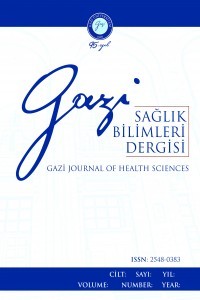OMUZ ANTERİOR KAPSÜLOLABRAL TAMİR YAPILAN BİREYLERDE CERRAHİ ÖNCESİ RİSK FAKTÖRLERİNİN FONKSİYONEL SONUÇLARA ETKİSİ
Omuz instabilitesi, spora dönüş, rotator kılıf
The effects of Pre-operative Risk Factors on Functional Outcomes on Patients with Shoulder Stabilization Surgery
shoulder instability, return to sport, rotator cuff,
___
- Referans1. Marshall T, Vega J, Siqueira M, Cagle R, Gelber JD, Saluan P. Outcomes After Arthroscopic Bankart Repair: Patients With First-Time Versus Recurrent Dislocations. The American journal of sports medicine. 2017;45(8):1776-82.
- Referans2. Longo UG, van der Linde JA, Loppini M, Coco V, Poolman RW, Denaro V. Surgical Versus Nonoperative Treatment in Patients Up to 18 Years Old With Traumatic Shoulder Instability: A Systematic Review and Quantitative Synthesis of the Literature. Arthroscopy : the journal of arthroscopic & related surgery : official publication of the Arthroscopy Association of North America and the International Arthroscopy Association. 2016;32(5):944-52.
- Referans3. Olds M, Ellis R, Donaldson K, Parmar P, Kersten P. Risk factors which predispose first-time traumatic anterior shoulder dislocations to recurrent instability in adults: a systematic review and meta-analysis. British journal of sports medicine. 2015;49(14):913-22.
- Referans4. Cordasco FA, Lin B, Heller M, Asaro LA, Ling D, Calcei JG. Arthroscopic shoulder stabilization in the young athlete: return to sport and revision stabilization rates. Journal of shoulder and elbow surgery. 2020;29(5):946-53.
- Referans5. Memon M, Kay J, Cadet ER, Shahsavar S, Simunovic N, Ayeni OR. Return to sport following arthroscopic Bankart repair: a systematic review. Journal of shoulder and elbow surgery. 2018;27(7):1342-7.
- Referans6. Gerometta A, Rosso C, Klouche S, Hardy P. Arthroscopic Bankart shoulder stabilization in athletes: return to sports and functional outcomes. Knee surgery, sports traumatology, arthroscopy : official journal of the ESSKA. 2016;24(6):1877-83.
- Referans7. Abdul-Rassoul H, Galvin JW, Curry EJ, Simon J, Li X. Return to Sport After Surgical Treatment for Anterior Shoulder Instability: A Systematic Review. The American journal of sports medicine. 2019;47(6):1507-15.
- Referans8. Van der Linde JA, van Kampen DA, Terwee CB, Dijksman LM, Kleinjan G, Willems WJ. Long-term results after arthroscopic shoulder stabilization using suture anchors: an 8- to 10-year follow-up. The American journal of sports medicine. 2011;39(11):2396-403.
- Referans9. Brophy RH, Marx RG. The treatment of traumatic anterior instability of the shoulder: nonoperative and surgical treatment. Arthroscopy : the journal of arthroscopic & related surgery : official publication of the Arthroscopy Association of North America and the International Arthroscopy Association. 2009;25(3):298-304.
- Referans10. Shibata H, Gotoh M, Mitsui Y, Kai Y, Nakamura H, Kanazawa T, et al. Risk factors for shoulder re-dislocation after arthroscopic Bankart repair. Journal of orthopaedic surgery and research. 2014;9:53.
- Referans11. Porcellini G, Campi F, Pegreffi F, Castagna A, Paladini P. Predisposing factors for recurrent shoulder dislocation after arthroscopic treatment. The Journal of bone and joint surgery American volume. 2009;91(11):2537-42.
- Referans12. Randelli P, Ragone V, Carminati S, Cabitza P. Risk factors for recurrence after Bankart repair a systematic review. Knee surgery, sports traumatology, arthroscopy : official journal of the ESSKA. 2012;20(11):2129-38.
- Referans13. Zhu W, Lu W, Zhang L, Han Y, Ou Y, Peng L, et al. Arthroscopic findings in the recurrent anterior instability of the shoulder. European journal of orthopaedic surgery & traumatology : orthopedie traumatologie. 2014;24(5):699-705.
- Referans14. Gasparini G, De Benedetto M, Cundari A, De Gori M, Orlando N, McFarland EG, et al. Predictors of functional outcomes and recurrent shoulder instability after arthroscopic anterior stabilization. Knee surgery, sports traumatology, arthroscopy : official journal of the ESSKA. 2016;24(2):406-13.
- Referans15. Wilk KE, Macrina LC. Nonoperative and postoperative rehabilitation for glenohumeral instability. Clinics in sports medicine. 2013;32(4):865-914.
- Referans16. Adam M, Attia AK, Alhammoud A, Aldahamsheh O, Al Ateeq Al Dosari M, Ahmed G. Arthroscopic Bankart repair for the acute anterior shoulder dislocation: systematic review and meta-analysis. International orthopaedics. 2018;42(10):2413-22.
- Referans17. Bigoni M, Gorla M, Guerrasio S, Brignoli A, Cossio A, Grillo P, et al. Shoulder evaluation with isokinetic strength testing after arthroscopic rotator cuff repairs. Journal of shoulder and elbow surgery. 2009;18(2):178-83.
- Referans18. Westrick RB, Miller JM, Carow SD, Gerber JP. Exploration of the y-balance test for assessment of upper quarter closed kinetic chain performance. International journal of sports physical therapy. 2012;7(2):139-47.
- Referans19. Tucci HT, Martins J, Sposito Gde C, Camarini PM, de Oliveira AS. Closed Kinetic Chain Upper Extremity Stability test (CKCUES test): a reliability study in persons with and without shoulder impingement syndrome. BMC musculoskeletal disorders. 2014;15:1.
- Referans20. Lädermann A, Denard PJ, Tirefort J, Kolo FC, Chagué S, Cunningham G, et al. Does surgery for instability of the shoulder truly stabilize the glenohumeral joint?: A prospective comparative cohort study. Medicine. 2016;95(31):e4369.
- Referans21. Smith RL, Brunolli J. Shoulder kinesthesia after anterior glenohumeral joint dislocation. Physical therapy. 1989;69(2):106-12.
- Referans22. Edouard P, Degache F, Beguin L, Samozino P, Gresta G, Fayolle-Minon I, et al. Rotator cuff strength in recurrent anterior shoulder instability. The Journal of bone and joint surgery American volume. 2011;93(8):759-65.
- ISSN: 2548-0383
- Yayın Aralığı: Yılda 3 Sayı
- Başlangıç: 2015
- Yayıncı: Gazi Üniversitesi
YETİŞKİN BİREYLERİN ÖĞÜN TÜKETİM SIKLIĞI İLE ORTOREKSİYA NERVOZA EĞİLİMLERİNİN DEĞERLENDİRMESİ
İrem OLCAY EMİNSOY, Gökhan EMİNSOY
GÖÇMEN KADINLARIN BESLENMEYE DAİR SORUNLARI
İrem Nur ŞENER, Ayşenur EREKDAĞ, Ayşe ZENGİN ALPÖZGEN
Barış METİN, Mehmet Kaan İLDİZ
YENİDOĞAN ve ÇOCUK BİREYLERDE KARDİYOPULMONER REHABİLİTASYON GEREKTİREN HASTALIKLAR
Tuğçe ATALAY, Betül Beyza DURMUŞ, Ufuk YURDALAN
Halime ARIKAN, Seyit ÇITAKER, Cahit ÜÇOK, Özlem ÜÇOK
Taha YİLDİZ, Egemen TURHAN, Durmus Ali OCGUDER, Gazi HURİ, İrem DÜZGÜN
MÜZİSYENLERİN AĞRI, POSTÜR, ÜST EKSTREMİTE FONKSİYONU VE ANKSİYETE DÜZEYLERİNİN İNCELENMESİ
Özel Sağlık Bakım Gereksinimi Olan Çocukların Ebeveynlerine Yönelik Eğitim Programlarının Önemi
Ahu ÇIRLAK, Ebru KILIÇARSLAN TÖRÜNER
Meltem KOÇ, Hüseyin AYDOĞMUŞ, Funda DİNÇ ELİBOL, Deran OSKAY, Kılıçhan BAYAR
